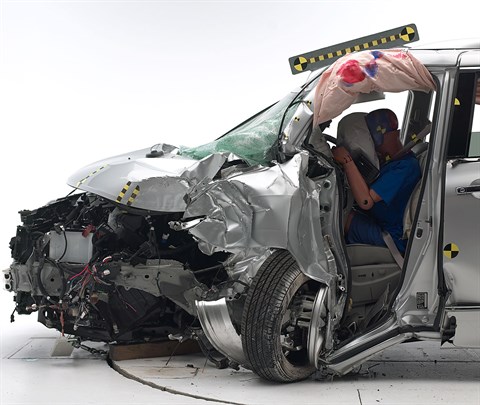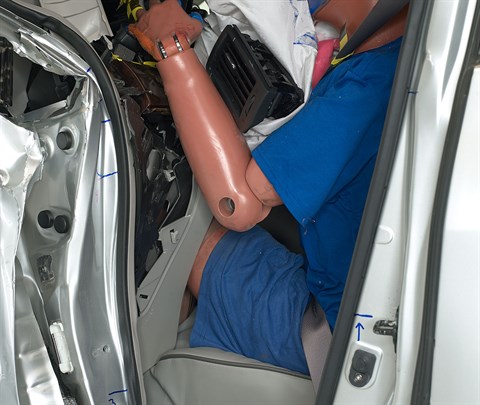Small overlap front: driver-side
Rating applies to 2011-17 models
Tested vehicle: 2014 Nissan Quest 3.5 SL
The Nissan Quest was redesigned for the 2011 model year.
| Evaluation criteria | Rating |
|---|---|
| Structure and safety cage | |
| Driver injury measures | |
| Head/neck | |
| Chest | |
| Hip/thigh | |
| Lower leg/foot | |
| Driver restraints and dummy kinematics | |

Action shot taken during the small overlap frontal crash test.

The dummy's position in relation to the door frame, steering wheel, and instrument panel after the crash test indicates that the driver's survival space was severely compromised.

Extensive intrusion wedged the dummy into a tight space during the crash, and the steering column moved too far upward.

Severe intrusion of the door hinge pillar, instrument panel, and parking brake contributed to a high risk of injuries to the left thigh, left knee, and left lower leg and foot and a moderate risk to the right thigh. The dummy's left leg was trapped between the seat and instrument panel; the seat had to be removed to free the dummy.
Moderate overlap front: original test
Rating applies to 2011-17 models
Tested vehicle: 2011 Nissan Quest SL
The Nissan Quest was redesigned for the 2011 model year. Frontal ratings are assigned by the Institute based on a test conducted by Nissan.
| Evaluation criteria | Rating |
|---|---|
| Overall evaluation | |
| Structure and safety cage | |
| Driver injury measures | |
| Head/neck | |
| Chest | |
| Leg/foot, left | |
| Leg/foot, right | |
| Driver restraints and dummy kinematics | |
Side: original test
Rating applies to 2016-17 models
Tested vehicle: 2016 Nissan Quest SL
The Nissan Quest was redesigned for the 2011 model year. Beginning with 2016 models, side modifications were made to improve the vehicle's performance in safety compliance tests mandated by the federal government. Side ratings are assigned by the Institute based on a test of a 2016 Quest conducted by Nissan.
| Evaluation criteria | Rating |
|---|---|
| Overall evaluation | |
| Structure and safety cage | |
| Driver injury measures | |
| Head/neck | |
| Torso | |
| Pelvis/leg | |
| Driver head protection | |
| Rear passenger injury measures | |
| Head/neck | |
| Torso | |
| Pelvis/leg | |
| Rear passenger head protection | |
Roof strength
Rating applies to 2011-17 models
Tested vehicle: 2011 Nissan Quest 3.5 SL
| Overall evaluation | |
|---|---|
| Curb weight | 4,501 lbs |
| Peak force | 15,119 lbs |
| Strength-to-weight ratio | 3.36 |
Head restraints & seats
Seat type: Power leather seats
| Overall evaluation | |
|---|---|
| Dynamic rating | |
| Seat/head restraint geometry |
About the head restraint & seat test
Currently, IIHS tests apply only to front seats.
Child seat anchors
Rating applies to 2014-17 models
| Evaluation criteria | Rating |
|---|---|
| Overall evaluation | |
| Vehicle trim | 3.5 LE |
| Seat type | leather |
This vehicle has 3 rear seating positions with complete child seat attachment (LATCH) hardware.
It has 1 additional seating position with a tether anchor only.
| Evaluation criteria | Rating |
|---|---|
| Overall evaluation | |
| Vehicle trim | 3.5 LE |
| Seat type | leather |
| Rating icon | Rating |
|---|---|
| G | Good |
| A | Acceptable |
| M | Marginal |
| P | Poor |
| Seating positions that rely on borrowed lower anchors or have only a tether anchor available are not rated. | |
thether anchor symbol | Tether anchor |
lower anchor symbol | Lower anchors |
| Lower anchor(s) can be borrowed from adjacent positions(s) | |
| No hardware available |
Details by seating position
| Position | Rating |
|---|---|
| 1 | |
| Tether anchor | |
| hard-to-find location | |
| no other hardware could be confused for anchor | |
| Lower anchors | |
| too deep in seat | |
| not too much force needed to attach | |
| difficult to maneuver around anchors | |
| 3 | |
| Tether anchor | |
| hard-to-find location | |
| no other hardware could be confused for anchor | |
| Lower anchors | |
| too deep in seat | |
| not too much force needed to attach | |
| difficult to maneuver around anchors | |
| 4 | |
| Tether anchor | |
| easy-to-find location | |
| no other hardware could be confused for anchor | |
| Lower anchors | |
| too deep in seat | |
| not too much force needed to attach | |
| difficult to maneuver around anchors | |
| 5 | |
| Tether anchor | |
| easy-to-find location | |
| no other hardware could be confused for anchor | |
| Lower anchors | |
| none available |
